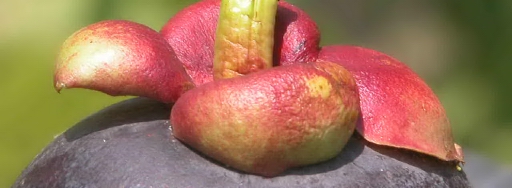
www.mangosteen.com

Acknowledgements
This web site is a personal effort spanning several years and countless hours of research. But from the very beginning I needed help in gathering information and I found it from all around the globe.
I asked and received input and documents and suggestions from people who are a credit to their institutions. I want them to know that without their help, you would not be reading this or seeing this web site in the present form it seemed headed towards in fits and starts from the beginning. Help came in from several continents, from many nationalities, from people who spoke a second language to help me. I am sure that I sorely tested the patience of some and had others simply scratching their heads in amazement or incredulity at my seemingly unending obsession with the mangosteen. Some probably just hoped I would go away. And I have to say up front that if it were not for the extraordinary patience of my wife I never could have gotten this far on the web site you see before you.
I must assert that any and all comments and observations contained herein are mine and mine alone and I accept all responsibility without qualification for the conclusions made and the observations put forward in this web site. No one who provided me with help should be held in any way responsible for my presentation of the data or my interpretation of its content.
That said, I want to single out both individuals and the institutions they represented so well. In no particular order, I must start with Marie Long of the LuEsther T. Mertz Library of the New York Botanical Garden, Nancy Korber of Fairchild Tropical Botanic Garden and Katherine Powis of the Horticultural Society of New York. These three people provided me with a starting point and a map along the way. I kept going back to them for extra help and they gave of their time and their institutions' resources without hesitation.
Further thanks go out to the whole highly professional staff at the National Agricultural Library, Craig Brough of the Royal Botanical Gardens at Kew (http://www.rbgkew.org.uk/), the registrar at the Royal Archives in Britain, the British Newspaper Library (http://www.bl.uk/collections/newspapers.html), Paul Carter of the British Library (www.bl.uk), the Natural History Museum in London, England (http://www.nhm.ac.uk/), the Royal Society for the Encouragement of Arts, Manufactures & Commerce (http://www.rsa.org.uk/), Francis Zee in Hawaii with the USDA germplasm facility, the Royal Horticultural Society in England (http://www.rhs.org.uk/), the National Archives of the UK (http://www.nationalarchives.gov.uk/), and Mr. Neff and Carol C. at the American Society for Horticultural Science (http://ashs.org/).
A special thanks to the Plant Explorers site (http://plantexplorers.com) and my contact there, J. W. Kingsley. Sometimes you come across some information that overlaps with your primary area of research and this site does that in a very orderly and concise way. The involvement of Joseph Banks and Captain William Bligh with the mangosteen is indicated in my web site (see History and Folklore) but the broader context of the times are beautifully presented at http://plantexplorers.com/. I recommend it to anyone with an interest in the history of botany and the people who were an integral part of it. In particular, I would draw attention to the pages on Sir Joseph Banks starting with;
http://plantexplorers.com/explorers/biographies/banks/joseph-banks-01.htm
I would also like to thank Patricia at the Thoroughbred Registry (http://www.tbheritage.com) for filling in some gaps. There were many people who never got back to me, probably thought I was nuts, just did not have the time or the inclination and then there were people like Patricia who had nothing to gain, nothing to lose except some time and who shared with me some information I would have been hard-pressed to get any other way. In a similar vein, I want to thank Lucy Moore for clearing up a point of information that went to the core of my research regarding Queen Victoria and the mangosteen. Very grateful to both of you for giving me some of your time and input.
I was also granted access to several databases that ultimately had no pertinent information for my narrow purposes but which enabled me to further explore this topic, the mangosteen, in greater depth. Put another way, you can not know what is under a rock until you lift it up and look. But that does not guarantee that the answers will be there and if they are not, at least you will then know that you must look elsewhere! I thank the Gale Group (galegroup.com) for their assistance and access to the huge database they maintain.
I also want to thank Pat in the UK for generously providing me with a copy of the letter that was written by Eleanor, Duchess of Northumberland. He is associated with a historically and visually rich locale in the UK and the web site he is involved with is http://aldbrough-st-john.co.uk/website/. And I owe him a beer. Maybe two.
And a final thanks to R. D. of Griffith University for our dialogue via email on the genetics of the mangosteen. The paper I am referring to by Rod and his group is cited elsewhere in this web site (Science, Non-Science and Nonsense) but I wanted to express my gratitude to Rod for taking time out from his hectic scholastic workload to answer some of my mangosteen-related questions (http://www.griffith.edu.au/).